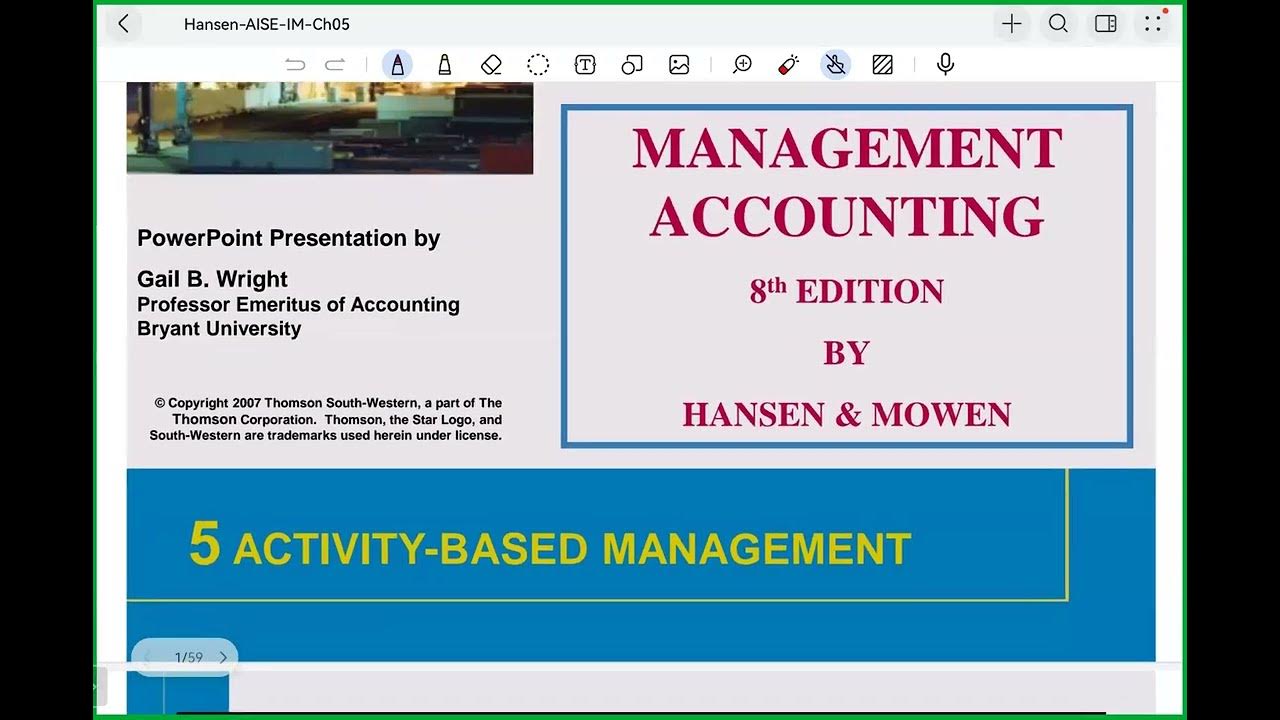Teori Activity Based Costing ABC Akuntansi Manajemen
Summary
TLDRThis video script discusses Activity-Based Costing (ABC) in management accounting. It explains how ABC offers a more accurate cost calculation compared to traditional costing methods by assigning costs to activities related to products. The script highlights the benefits of ABC, such as providing detailed cost information for decision-making and addressing issues like customer variety and global competition. It also touches on the challenges of implementing ABC, like the difficulty of cost allocation and the need for significant investment in time and resources. The script concludes with an example comparing traditional costing with ABC, emphasizing the accuracy and fairness of ABC in profit distribution across products.
Takeaways
- 📚 Activity-Based Costing (ABC) is a method for determining the cost of a product based on the activities involved in its production.
- 🔍 ABC is more accurate than traditional costing methods, providing a detailed breakdown of costs associated with specific activities.
- 🚀 The emergence of ABC addresses the inaccuracies found in traditional methods, such as the inability to differentiate costs between products like bread and tarts due to similar overhead costs.
- 🌟 ABC allows for the customization of products to meet diverse consumer demands, which is essential in a competitive global market.
- 💼 ABC is beneficial for companies looking to improve operational efficiency and make more informed decisions regarding product pricing and profitability.
- ⏱️ Implementing ABC requires significant time and resources, including the establishment of a dedicated team to develop and implement the system.
- 💡 ABC provides relevant cost information for decision-making, helping to identify the most profitable activities and optimize resource allocation.
- 📈 The method can be applied in manufacturing companies to accurately allocate overhead costs, which are often the most challenging to assign in traditional costing.
- 📊 ABC involves identifying activities, determining the costs associated with each activity, and then assigning these costs to products based on their consumption of activities.
- 🌐 ABC can reveal significant differences in product profitability when compared to traditional costing, leading to more accurate business strategies and potentially altering production focus.
Q & A
What is Activity-Based Costing (ABC)?
-Activity-Based Costing (ABC) is a costing method that determines the cost of a product based on the activities involved in its production, where each activity is then multiplied by its cost per activity.
How does ABC differ from traditional costing methods?
-ABC is more accurate than traditional methods as it allocates costs based on activities and their usage, rather than simply allocating costs evenly across all products as in traditional methods.
What are the benefits of using ABC?
-ABC provides more accurate and informative cost data, allows for better understanding of cost drivers, and offers relevant cost information for decision-making, leading to more effective and efficient cost management.
What are the limitations of implementing ABC?
-Determining cost allocation for each activity can be challenging, and it may ignore other cost analyses such as advertising and promotion. Additionally, implementing ABC requires significant investment in time and resources, including the need for a dedicated team.
Why is it important for a company to know the cost of a product?
-Knowing the cost of a product is essential for determining inventory value, setting selling prices, making financial reports, and deciding whether to continue or discontinue a product line.
What is a cost driver in the context of ABC?
-A cost driver in ABC is the activity that causes the use of resources and is then translated into cost. It is used to measure the overhead costs and to determine the actual costs incurred or to set budgetary costs.
How does ABC help in managing overhead costs?
-ABC allocates overhead costs based on activities, ensuring that products with higher activity usage bear more costs, leading to a more accurate reflection of the true costs associated with each product.
What are the steps involved in implementing ABC?
-The steps include identifying activities, determining costs associated with each activity, grouping activities into cost pools, and calculating the cost per activity or cost driver.
How does ABC impact product pricing and competitiveness?
-ABC can lead to more accurate product pricing by reflecting the true cost of production, which can enhance competitiveness by ensuring that products are priced effectively in the market.
Can you provide an example of how ABC might be applied in a manufacturing company?
-In a manufacturing company, ABC can be applied by identifying activities such as material handling, machine setup, and order processing. The costs associated with these activities are then allocated to products based on their usage, leading to a more accurate calculation of the total cost of each product.
Outlines

This section is available to paid users only. Please upgrade to access this part.
Upgrade NowMindmap

This section is available to paid users only. Please upgrade to access this part.
Upgrade NowKeywords

This section is available to paid users only. Please upgrade to access this part.
Upgrade NowHighlights

This section is available to paid users only. Please upgrade to access this part.
Upgrade NowTranscripts

This section is available to paid users only. Please upgrade to access this part.
Upgrade NowBrowse More Related Video
5.0 / 5 (0 votes)





